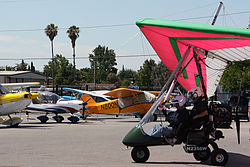The Federal Aviation Regulations (FARs) are rules prescribed by the Federal Aviation Administration (FAA) governing all aviation activities in the United States. The FARs comprise Title 14 of the Code of Federal Regulations. A wide variety of activities are regulated, such as aircraft design and maintenance, typical airline flights, pilot training activities, hot-air ballooning, lighter-than-air aircraft, man-made structure heights, obstruction lighting and marking, model rocket launches, commercial space operations, model aircraft operations, Unmanned Aircraft Systems (UAS) and kite flying. The rules are designed to promote safe aviation, protecting pilots, flight attendants, passengers and the general public from unnecessary risk.

Ultralight aviation is the flying of lightweight, 1- or 2-seat fixed-wing aircraft. Some countries differentiate between weight-shift control and conventional three-axis control aircraft with ailerons, elevator and rudder, calling the former "microlight" and the latter "ultralight".

Pilot certification in the United States is typically required for an individual to act as a pilot-in-command of an aircraft. It is regulated by the Federal Aviation Administration (FAA), a branch of the U.S. Department of Transportation (USDOT). A pilot may be certified under 14 Code of Federal Regulations (CFR) Part 61 or 14 CFR Part 141. Pilots may also be certified under 14 CFR Part 107 for commercial drone operations.

Ultralight aircraft exist outside of the United States. In most countries, ultralights are a class of aircraft. A completely different legal concept is valid within the USA. The FAA makes explicitly clear, that ultralight vehicles are no aircraft, are not regulated as aircraft, and are exempt from aircraft rules. Instead, they are treated as powersport items and have to follow their own ruleset, FAR-103, which is the most compact aviation regulation in existence. It can be printed on the front- and backside of a single piece of paper.

The Canadian Aviation Regulations define two types of ultralight aircraft: basic ultra-light aeroplane (BULA), and advanced ultra-light aeroplane (AULA).

The Flight Design CT series is a family of high-wing, tricycle undercarriage, two seat, ultralight and light-sport aircraft produced by Flight Design of Germany. The family includes the original CT and the CT2K, CTSW, CTLS and the MC models.
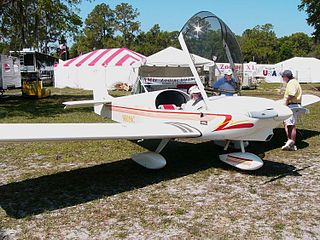
The Zodiac is a family of Canadian all-metal, two-seat, fixed landing gear airplanes that first flew in 1984. The aircraft have been produced as kits and completed aircraft by Zenair in Canada and Zenith Aircraft Company in the US.
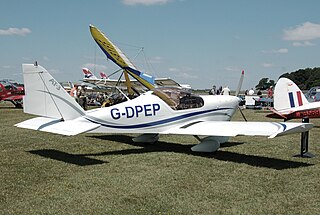
EASA CS-VLA is the European Aviation Safety Agency Certification Specification for Very Light Aircraft.

The Europa XS and Europa Classic are a family of British composite two-place low-wing monoplane kit aircraft. Designed by Ivan Shaw, the Europa was introduced in the early 1990s. Europas are manufactured by Europa Aircraft and supplied as kits for amateur construction. More than 450 Europas have been completed.

The Aeronca Model 7 Champion, commonly known as the "Champ", or "Airknocker", is a single-engine light airplane with a high wing, generally configured with fixed conventional landing gear and tandem seating for two occupants.

The Fantasy Air Allegro is a Czech two seat, high wing, tricycle gear, single engine monoplane light-sport aircraft or microlight originally designed and built by Fantasy Air and later produced in the United States by Allegro LSA.

The SportStar and EuroStar are a family of a two-seat, light sport aircraft (LSA), manufactured by Evektor-Aerotechnik of the Czech Republic and powered by a Rotax 912ULS, 100 horsepower (75 kW) engine.

In aviation, V-speeds are standard terms used to define airspeeds important or useful to the operation of all aircraft. These speeds are derived from data obtained by aircraft designers and manufacturers during flight testing for aircraft type-certification. Using them is considered a best practice to maximize aviation safety, aircraft performance, or both.

The Pipistrel Virus is a two-seat, single engine light aircraft manufactured by Pipistrel in Slovenia and Italy and sold as an ultralight, homebuilt kit, or light-sport aircraft.
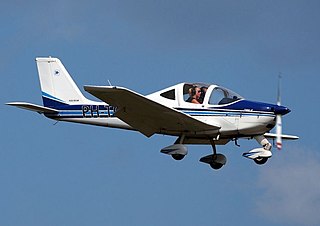
The Tecnam P2002 Sierra is a two-seat, low-wing, light aircraft designed and constructed by the Italian aircraft manufacturer Tecnam. Introduced during the early 2000s, the aircraft quickly became a staple of the company's product lineup, comprising 70 per cent of its available production capacity during some years.

The Breezer is a low-wing, single-engine ultralight aircraft, seating two side by side. Designed and built in Germany, it meets both European and US light-sport aircraft requirements and has been in production since 2001.

The Tomark Viper SD4 is a Slovak single–engine, all-metal, two-seat low wing monoplane with a fixed tricycle undercarriage and side-by-side seating for two people. The aircraft is built by Tomark s.r.o. of Prešov.

The Aerospool WT9 Dynamic is a Slovak ultralight and light-sport aircraft, designed and produced by Aerospool of Prievidza. The aircraft is supplied as a complete ready-to-fly-aircraft.
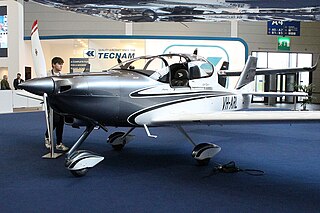
The Tecnam Astore is an Italian, low wing, two-seater, light-sport aircraft, under development by Tecnam of Naples. It was first flown in early June, 2013, and introduced at the AERO Friedrichshafen show in 2013. It is supplied complete and ready-to-fly.

The ScaleWings SW51 Mustang, formerly marketed as the FK-Lightplanes FK51 Mustang, is an Austrian ultralight, light-sport aircraft and homebuilt aircraft that was designed by ScaleWings of Strasswalchen, Austria and was initially produced by FK-Lightplanes of Krosno, Poland, who introduced it publicly at the AERO Friedrichshafen show in 2013. After FK-Lightplanes ceased production, the design was built by ScaleWings.
